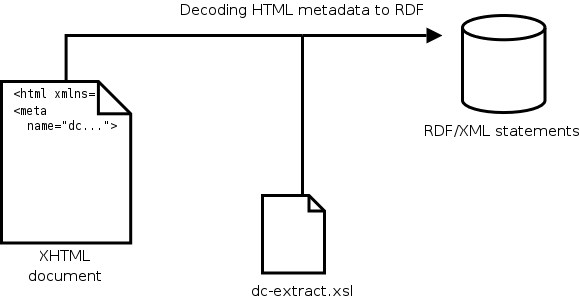Abstract
This document presents GRDDL, a mechanism for encoding RDF statements in
XHTML and XML to be extracted by programs such as XSLT transformations.
1. Introduction
An article by J. Kunze in 1999, Encoding Dublin Core Metadata in
HTML, explains one way that the Dublin Core community encodes its
metadata in HTML documents. This metadata can also be expressed in the
Resource Description Framework (RDF).
The mapping between the HTML encoding and the RDF encoding can be
represented as an XSLT transformation, dc-extract.xsl:

Decoding HTML metadata to RDF
(svg)
If the HTML author understood and agreed to these encoding conventions,
then their HTML document will conform to the syntactic conventions. In this
case, the mapping preserves the author's meaning. But an author may have
accidentally conformed to the syntactic conventions without any
knowledge of Dublin Core at all. In that case, the mapping most likely does
not preserve the author's meaning.
2. The GRDDL profile for
XHTML
The HTML specification, in section 7.4.4.3 Meta data profiles provides a mechanism for authors to
use particular metadata vocabularies and thereby indicate the author's
intent to use those terms in accordance with the conventions of the
community that originated the terms.
Authors may wish to define additional link types not described in this
specification. If they do so, they should use a profile
to cite the conventions used to define the link types.
GRDDL is such a profile; it's a mechanism for Gleaning
Resource Descriptions from Dialects of Languages.
Use of the http://www.w3.org/2003/g/data-view profile
indicates that RDF statements that result from transformation of the HTML
document to RDF by designated algorithms are part of the document's
meaning.
In this profile, the transformation link relationship relates a
document to an algorithm for for gleaning resource descriptions from the
dialect the document is written in.

Decoding HTML metadata to RDF
(svg)
@@@ Should we namespace-qualify token used in
rel?cf Profiles
attribute: A format to be defined Karl Dubost 15 Jan 2004.
For example:
<html xmlns="http://www.w3.org/1999/xhtml">
<head profile="http://www.w3.org/2003/g/data-view">
<title>Some Document</title>
<link rel="transformation"
href="http://www.w3.org/2000/06/dc-extract/dc-extract.xsl" />
<meta name="DC.Subject"
content="ADAM; Simple Search; Index+; prototype" />
...
</head>
...
</html>
The following RDF statement is part of the meaning of this document:
<rdf:RDF
xmlns:dc="http://purl.org/dc/elements/1.1/"
xmlns:rdf="http://www.w3.org/1999/02/22-rdf-syntax-ns#"
>
<rdf:Description rdf:about="">
<dc:subject>ADAM; Simple Search; Index+; prototype</dc:subject>
</rdf:Description>
</rdf:RDF>
Transformation algorithms should be represented in XSLT. While
javascript, C, or any other programming language technically expresses the
relevant information, XSLT is specifically designed to express XML to XML
transformations and has some good safety characteristics. Other
representations may be used by prior agreement of all concerned
parties.
Transformation algorithms should be well-defined functions whose
only input is the source document. The use of the XSLT
document() function to incorporate other data at transformation
time is an error.
Limitations on xsl:import?
Note that an XHTML document may conform to a number of dialects
simultaneously and link to more than one decoding algorithm. For example, the
fictional Joe
Lambda's Homepage demonstrates a mixture of Dublin Core, Creative
Commons, RSS, FOAF, and geoURL dialects.
3. The GRDDL attribute in XML
The GRDDL profile mechanism is a special case of GRDDL designed to fit
within the syntax of XHTML 1.0. The general form of GRDDL is an attribute
suitable for use with a wide variety of XML dialects.
Use of the interpreter attribute in the
http://www.w3.org/2003/g/data-view# namespace on the root
element of an XML document indicates that RDF statements that result from
transformation of the HTML document to RDF by designated algorithms are part
of the document's meaning.
The value of the grddl:interpreter attribute designates a
list of algorithms by URI reference. @@@IRI
reference?
For example: update to P3Q example?
<svg xmlns="http://www.w3.org/2000/svg"
xmlns:data-view="http://www.w3.org/2003/g/data-view#"
data-view:interpreter="http://www.example.org/2004/01/svg2dc.xsl"
width="4cm" height="8cm"
version="1.1" baseProfile="tiny" >
4. XML Namespaces and embedded RDF
The RDF property
http://www.w3.org/2003/g/data-view#namespaceTransformation
links an XML Namespace to an interpreter that may be applied to any document
which has its root element in that namespace, such that the output of the
interpreter will be an RDF/XML form of some (or all) of the information
content of the document.
For instance, given the XML Namespace
http://www.example.net/fooML,
<rdf:Description rdf:about="http://www.example.net/fooML">
<namespaceTransformation xmlns='http://www.w3.org/2003/g/data-view#'
rdf:resource='http://www.example.net/fooML2rdf.xsl' />
</rdf:Description>
asserts that if an XML document has a root element in the
http://www.example.net/fooML namespace, and it is run through
the XSLT style sheet http://www.example.net/fooML2rdf.xsl
then the result will be valid RDF/XML which is information which can be
considered to have been expressed by the document.
5. Security considerations
RFC 2046, in
section 9. Security Considerations says:
Implementors should pay special attention to the
security implications of any media types that can cause the remote
execution of any actions in the recipient's environment. In such
cases, the discussion of the "application/postscript" type may serve
as a model for considering other media types with remote execution
capabilities.
Given the expressive power of XSLT, and the possibility to access external
resources from a XSLT style sheet (e.g. through the document
function or the xsl:import mechanism), implementors should take
the appropriate measures to prevent malicious usage of this mechanism.

